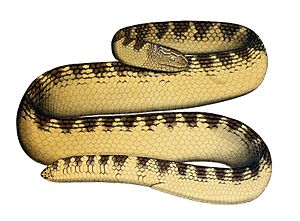Beaded sea snake facts for kids
Quick facts for kids Beaded sea snake |
|
|---|---|
 |
|
| Conservation status | |
| Scientific classification | |
| Genus: |
Aipysurus
|
| Species: |
eydouxii
|
The beaded sea snake (scientific name: Aipysurus eydouxii) is a special type of sea snake. It's also known as the marbled seasnake or spine-tailed seasnake. This snake is very unusual among sea snakes. It only eats fish eggs! Because of this unique diet, it has lost its fangs. Its venom glands are also very small.
Contents
What's in a Name?
The scientific name eydouxii honors a French naturalist. His name was Joseph Fortuné Théodore Eydoux. Naturalists are scientists who study nature.
Where Do They Live?
You can find the beaded sea snake in many places. They live in the waters around Western Australia, the Northern Territory, and Queensland in Australia. They are also found in the South China Sea and the Gulf of Thailand. Other homes include Indonesia, Peninsular Malaysia, Vietnam, and New Guinea.
What Do They Look Like?
Adult beaded sea snakes can grow up to about 1 meter (or 3 feet) long. Their heads have smooth, even scales. The scales on their back are also smooth. These scales are usually in 17 rows around the middle of their body. The scales on their belly are clear and distinct. There are usually between 141 and 149 belly scales.
Their Home in the Ocean
Beaded sea snakes like to live in shallow water. They are often found in bays and estuaries. Estuaries are places where rivers meet the sea.
What's for Dinner?
The beaded sea snake has a very special diet. It eats only the eggs of fish! This is quite rare for a snake. Because of this diet, their bodies have changed over time. They have strong muscles in their throat. Their lip scales are also different. They have fewer teeth, or sometimes no teeth at all. Their bodies are also smaller than many other sea snakes. Even their venom is much weaker. This is because they don't need strong venom to catch fish eggs.
Only one other type of sea snake eats only fish eggs. That snake is called Emydocephalus annulatus.


